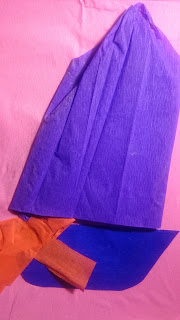When it comes to Alzheimer, or any other type of dementia, the person, even from the early stages, tends to have an impaired sense of orientation. Thus, it is important to define the place and time- constantly if necessary. In this manner, the person may not recall the specifics (such as each day and the date), but more general information could remain (the year, the season).
In this lens, individuals with Alzheimer's can participate in activities revolve around themes of orientation, accompanied by relevant discussion.
In individual sessions with an elderly lady with Alzheimer's, she was asked to conduct summer crafts.
First, a general discussion about summer took place every time: what are the months of the summer, is it hot or cold during that time, what do we usually do during the summer (going to the beach, swim), what do we usually eat, etc.
Afterwards, she proceded to the activity itself, and when that was complete, a conclusion was drawn: what was made and why, and whether she enjoyed the procedure.
A few weeks later, the same theme can be used combined with a different activity- for example at the beginning of each summer month. This provides the person with the opportunity to connect general orientation information with personal ones: in the current case, summer crafts were conducted four seperate times- each time the craft that was previously conducted was presented again, something which provided extra motivation, and a chance to recall.
The Crafts:
1. Fish Decoration
- Materials: wooden craft stick, thick paper, thin paper, plastic eyes, glue
- Procedure: first shape and cut the body of the fish from a thick paper; then fold the thin paper (so as to look like a tail); then glue them together (the tail is glued behind the body of the fish); then the entire fish is glued to the wooden stick, and finally the plastic eyes are added.
2. Fish Drawing
- Materials: nothing but some colours (crayons in this case)
- Procedure: fold the paper in three parts- as if to make a card; then attack the bottom folding to the top (leaving a part of the paper covered- folded); then draw the shape of the fish in the 'closed' paper, and upon unfolding it, complete the drawing
3. Shark Attack Craft
- Materials: Papers of different colours and textures, crayons, plastic eyes
- Procedure: Cut the shapes of the fish and glue them on a larger paper; then decorate with details (teeth, eyes, etc)
4. Summer Card Craft
- Materials: Thick craft paper, thin papers, colouring markers, glue
- Procedure: fold the paper in two; then draw on one side; and then glue a thin paper for a background on the other side; finally cut the shapes of the ship and glue them on the other side.
- In this craft, the person became really interested, and took some time to consider the 'setting' of the card. In the end she created something she liked a lot, which made her happy!
Simply telling a person about the place and time may not be enough for them to remember. But if combined with an activity, the person has a lot more cues to pick up and recall. Thus, in this way, the individual does not only eperience the benefits of the activity itself (such as exercising fine motor skills, attention, or engagement) but will also orient in time and place. This is turn, will provide with discussion materials for future sessions: in the days afterwards, the activity can be used as a reminder, not only of the effort apllied to it, but also of the time and place.
Literature: J. Creek, L. Lougher, 2008. Occupational Therapy and Mental Health, Athens, ΒΗΤΑ medical arts; Ν. Tsergas, 2014. Therapeutic Approaches Through Art, Αthens, Topos; Katsari, Margioti, Nika, Sakka, 2011. Activities for Individuals who Suffer from Alzheimer's Disease, Athens, Grigoris Publications
Note: The current activity was conducted in an individual level in the sphere of creative work and cognitive reinforcement in a specific elderly care unit in Athens.











Δεν υπάρχουν σχόλια:
Δημοσίευση σχολίου